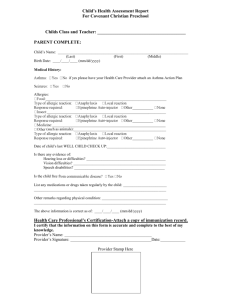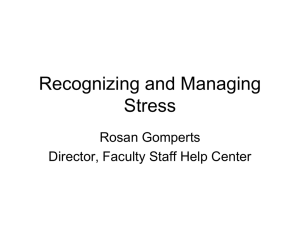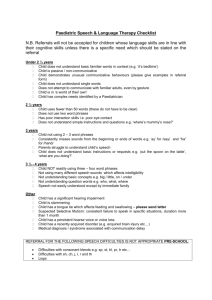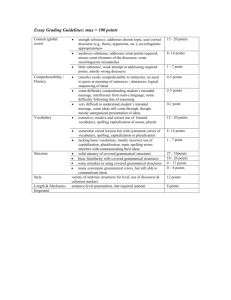Speech and Language Descriptors
advertisement
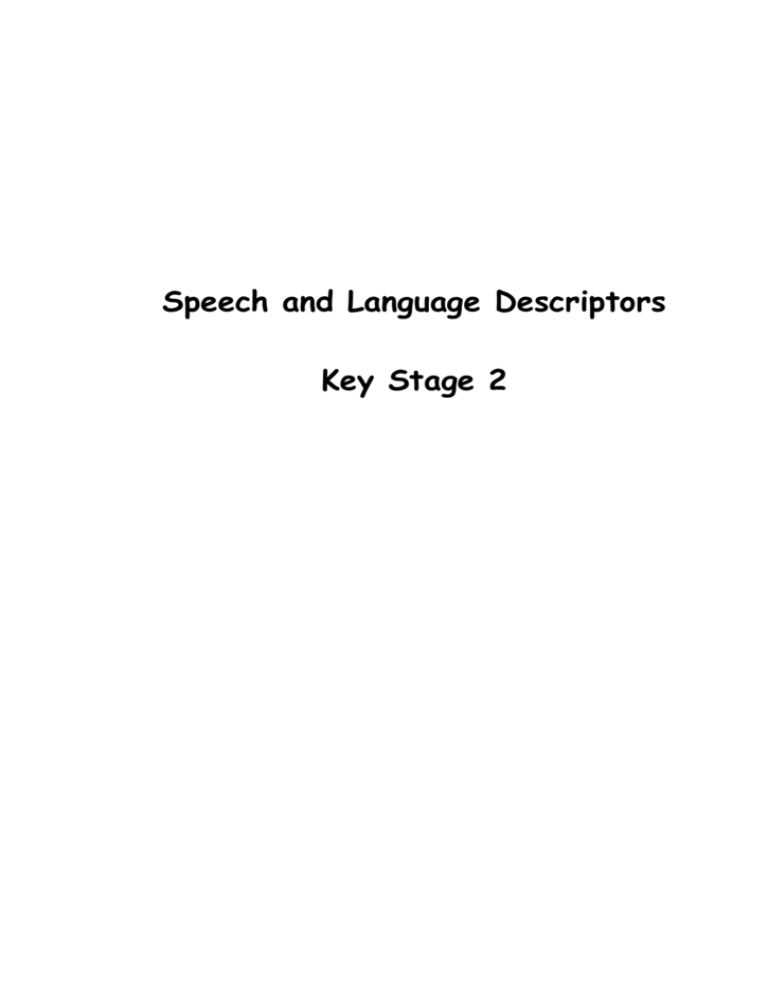
Speech and Language Descriptors Key Stage 2 Key Stage 2 - Speech and Language Descriptor Level 4 Listening and attention age appropriate Understanding language in context questions/ instructions/ discussion occasionally misunderstood occasionally needs extra time to respond to verbal stimuli Understanding semantic and abstract language most concepts known, except for some abstract ones, e.g. those found in history and/ or science curriculum only obvious, here and now, definitions given Use of vocabulary uses a narrow range of vocabulary Use of grammatical structure grammar usually correct can use connectives e.g. ‘but’, ‘because’, ‘if’ Use of discourse may give simple narrative about familiar event/ story Speech minor sound errors; no pattern, but different sounds changed in different words immature production of multi-syllabic words Interaction may communicate more with peers than adults or vice versa adult commonly using 1 or 2 supporting strategies (see page 7) some idea of non-literal language and inference may need some reinforcement to learn/ retain new vocabulary sometimes forgets words, but can usually selfcorrect connectives usually linking very simple utterances e.g. ‘I went to the park and I went on the swing’ may need adult help to sequence/ extend conversation into connected discourse little potential for change intelligibility may break down in connected speech starting to self-monitor and to take account of listener knowledge Key Stage 2 - Speech and Language Descriptor Level 3 Listening and attention sometimes needs reminders to listen when 1-1, more often in a small group and most often in a large group Understanding language in context questions/ instructions/ discussion sometimes misunderstood difficulty following instructions with more than 4 key words delayed understanding, with equal delay seen in other skills e.g. visual, motor, social Understanding semantic and abstract language immature vocabulary knowledge: some gaps in basic vocabulary difficulty in grasping that words are defined by more than one feature some concepts known; others uncertain Use of vocabulary immature use of vocabulary needs opportunities set up by adults to practise use of vocabulary in a required situation Use of grammatical structure some immature grammar e.g. plural ‘mouses’, tenses ‘broked’, conjunctions ‘that’s why’ used for ‘because’ Use of discourse may only give key details Speech sound system delayed e.g. saying t,d instead of ch,j and w,l instead of r,y (after 8,0 years), persisting difficulties with production of multi-syllabic words: spelling may be affected some slow response to focused intervention difficulties with generalisation mildly impaired appreciation and use of non-literal language may need some reinforcement to learn/ retain new vocabulary sometimes needs cues to retrieve words, especially new items, e.g. ‘what is it for?’, ‘where did you see it?’, ‘does it start with “c”?’ occasional grammatical omissions e.g. endings such as –es, -ed uses simple but complete sentences sometimes loses coherence sometimes intelligibility breaks down in connected speech lack of voice, or hoarseness or harshness affecting ability to communicate mild but persistent stammer with minimal impact on communication Interaction mild impairment of understanding and use of nonverbal communication such as gesture, facial expression eye contact, reciprocal smiling limited use of language, e.g. may not ask questions poor recall and retention of information sometimes needs extra time to respond to verbal stimuli adult commonly using 2 or more supporting strategies (see page 7) sometimes makes mistakes about a listener’s needs recognises breakdown e.g. looking puzzled or noticing confusion, but needs adult help to locate breakdown and to repair Key Stage 2 - Speech and Language Descriptor Level 2 Listening and attention better attention for activities involving non verbal skills than for language based tasks may need some prompting to listen in a group Understanding language in context questions/ instructions/ discussion frequently misunderstood very slow response to verbal stimuli Understanding semantic and abstract language knowledge of concepts may be restricted may misunderstand non-literal language, irony or humour Use of vocabulary limited expressive vocabulary uneven learning of topic vocabulary may need frequent revision of all vocabulary Use of grammatical structure difficulties with rules of grammar, leading to unequal development e.g. good use of conjunctions but poor use of pronouns Use of discourse may only convey limited information; hard to follow out of context difficulties organising language in sequence to describe or explain Speech sound system severely delayed e.g. saying t,d instead of k,g; b,d,g instead of sp,st,sk; w,l instead of r,y (after 8 years) sound system disordered, but following an identifiable pattern may be difficult to understand even when the subject of conversation is known by listener Interaction impaired use and appreciation of nonverbal communication such as gesture, facial expression, eye contact, reciprocal smiling may use language for limited range of purpose some difficulties in initiating and/ or sustaining appropriate interaction may need to learn and be given specific signals to gain/ maintain attention within a group or 1-1 adult commonly using 3 or more supporting strategies (see page 7) understanding sometimes reliant on adult help difficulties in making connections between old and new information may need some focused teaching and reinforcement difficulty in naming objects or actions, despite ability to point to them may not recall words, even familiar items uses hesitations, ‘thingy’ etc. some grammatical omissions difficulties in constructing written sentences tends to ramble or be imprecise difficulty recognising syllable structure of words difficulty recognising that groups of words rhyme moderate to severe persistent stammer, with significant impact on communication uses language that is inappropriate to the situation, e.g. is socially inappropriate or overfamiliar may misjudge how to talk to different people in different situations expects the listener to understand what they are talking about does not always notice conversational breakdown Key Stage 2 - Speech and Language Descriptor Level 1 Listening and attention attention is fleeting or unfocused Understanding language in context questions/ instructions/ discussion usually misunderstood may only respond to key or familiar words/ concepts limited understanding of concepts and/ or vocabulary and/ or grammar Understanding semantic and abstract language many gaps in basic vocabulary knowledge few concepts known low retention of abstract words poor understanding of non-literal language, irony or humour Use of vocabulary uses no words or gestures uses very limited vocabulary restricted use of verbs, e.g. ‘got’, ‘went’, ‘did’ used for wide range of meaning needs frequent revision of all vocabulary Use of grammatical structure relies on gesture rather than words only using simple phrases and/ or learnt phrases (echolalia) difficulties in constructing utterances or written sentences Use of discourse unable to convey meaning gives limited information, hard to follow out of context, or tangential answers difficulties organising or planning: stories, picture description, retelling events are muddled; becomes rambling or imprecise Speech limited range of sounds used difficulty in copying speech sounds severe delay in development of sound system e.g. saying b,d,g instead of f,s,sh; t,d instead of k,g, and b,d,g instead of sp,st,sk needs constant support to sustain attention, even 1-1 very limited, slow or inconsistent response to verbal stimuli adult commonly using wide range of supporting strategies (see page 7) understanding reliant on adult help AAC may be essential poor understanding of simple inference difficulties in making connections between old and new information needs high level of focused teaching and reinforcement significant difficulty in naming objects or actions, despite ability to point to them may not recall words, even familiar items often uses hesitations, ‘thingy’ etc. many grammatical omissions word order may be incorrect few ‘linking’ words used, e.g. ‘because’ may need to use AAC no clear beginning, middle or end to stories/ accounts people and places in story/ accounts not clearly identified uses sentences, but content lacks meaning some unusual sounds used difficulty telling the difference between similar sounds s/ f and sounds in words saw/ four very difficult to understand even when the subject of conversation is known by the listener cont. Key Stage 2 - Speech and Language Descriptor Level 1 - continued Interaction failure to appreciate and/ or use nonverbal communication such as gesture, facial expression, eye contact, reciprocal smiling difficulties in maintaining or changing topic of conversation significant difficulties in initiating and/ or sustaining appropriate interaction uses language that is inappropriate to the situation, e.g. is socially inappropriate or overfamiliar may use constant echolalia expects the listener to understand what they are talking about does not notice conversational breakdown learns best from direct teaching in small groups and/ or adult prompts to use learnt strategies in context



